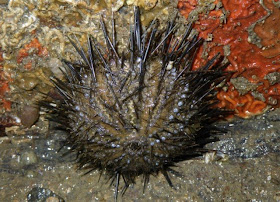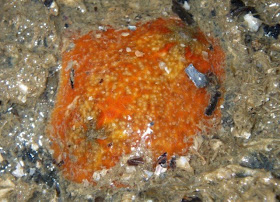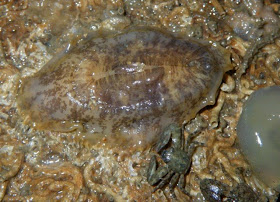Finally we could enjoy a trip without any light shows or thunder sounds. :P

The first surprise of the day when we started exploring will be this colourful Hypselodoris nudibranch (Hypselodoris sp.) that I've found beneath a rock. It is possibly Hypselodoris infucata.

In fact, there are many more other of this nudibranch found throughout the trip. Glad they are doing fine. These nudibranchs eat sponges and then absorb the toxic chemicals in their food. Then they incorporate these chemicals into the mantle glands on their backs where they repel predators.

Talking about sponges, there are many different colourful sponges on the rocky shore though they seem not to be really that abundant. I wonder why?
The shore was filled with benzene smell and the sea seems to have a layer of oil. Nevertheless, it is heartening that other marine life still thrives.

The big patch of the zoanthids are still there and they are possibly Zoanthus vietnamensis. They have a bright "Hello Kitty" or "Bandung" pink at the centre. More about zoanthids in Changi at the wildfilms blog.

The second surprise of the day will be this Feather star (Order Comatulida) that Ria found! This Feather star looks slightly different from the ones I found yesterday at Hantu.

In fact, I find it so pretty that I feel it is the most beautiful feather star I've ever seen on our shores! What a pleasant sighting.

Closeup views of the stunning feather star: Left- Upperside, Right- Lowerside.
Feather stars can move about by moving their arms. They crawl over soft sediments, using their arms to drag themselves over the surface

And then much later, James found the second feather star! Wow, today's really good because I don't think I've ever seen feather star in Changi before.
However, a closer look reveals that some arms are shorter than others. Like brittle stars, feather stars can purposely drop off an arm or two when threatened. I hope that this feather star will recover all of its lost arms.

More echinoderms that one can find at a rocky shore will be the Crown sea star (Asterina coronata). They are usually found at rocky shores though once in a while sighted with seagrasses for instance at Semakau's seagrass meadow.

The only sea urchin type found during today's trip will be this Black sea urchin (Temnopleurus toreumaticus).
However, there are still many different types of sea cucumbers!

Like this unidentified Purple under-a-stone sea cucumber that clung onto the rock.

It was nice to also spot this Sponge synaptid sea cucumber.

And many more different types of sea cucumber thrives in the rocky shore of Changi.
Top left: Beige sea cucumber
Top right: Orange sea cucumber
Bottom left: Ball sea cucumber (Phyllophorus sp.)
Bottom right: Thorny sea cucumber (Colochirus quadrangularis)

Another sea cucumber like creature that can squirt water will be this unknown orange blob. I suspect it is actually an ascidian or sea squirt. Could it be the Orange lobed ascidian?

Talking about ascidians, there is also another kind of ascidian called the Yellow clustered bead ascidians (Eudistoma sp.) and today we saw many of the Blue-spotted flatworm (Pseudoceros indicus) enveloping over these ascidians. The flatworms could be feeding on them!

Another worm spotted will be this Ribbon worm (Phylum Nemertea) found by James. I have not seen such a type of ribbon worm though. Cool!

These creatures are worms though they don't look like the typical longish worm which you are more familiar with. They are Fan worms (Family Sabellidae) like this orange fan worm (right) and the banded fan worm (left).

I was looking out for the Sea fans or Gorgonians (Order Gorgonacea) and was delighted to find them at the deeper waters, attached to rocks.
What surprises me is that they are many more of these stunning gorgonians along the rocky bay.

I dipped my UW camera, again, into the silty waters and captured some photos of these wonderful sea fans underwater.

Some are really beautiful and extensive. This colony of sea fan in particular seems to have the purplish Sponge synaptid sea cucumber curled around it.

Some sea fans look really majestic with most of their polyps fully opened in the waters.

Sea fans are related to corals and one type of coral found today will be these solitary cave corals (Tubastrea sp.), They are a kind of coral that are more commonly found in caves as they don't need sunlight like most other hard corals. This seems quite adequate because some parts of the rocks are not exposed to any sunlight.

Beneath rocks are many Wandering cowrie (Cypraea errones).

However, this cowrie-looking creature is not a cowrie but a Hoof-shield limpet (Scutus sp.). Its body is a lot larger than its shell, usually folded up around the edges of the shell and may cover most of the shell. 'Scutus' comes from the word 'suctum' which is the name of the Roman shield that the shell resembles.
And near the hoof-shield limpet are two Tiny under-a-stone porcelain crab (Family Porcellanidae)! More about today's crabby finds here.

James found another species of the hoof-shield limpet and it is Scutus unguis! It has a black body instead. It's a surprising find since I have not seen this species before. This species however is listed as 'Endangered' on Red List of threatened animals of Singapore due to habitat loss. We hope that the remaining few rocky shores of Singapore will no longer be destroyed so that we can still sustain populations of endangered species in Singapore.

The final and the best surprise must be the Smooth Otter (Lutrogale perspicillata) than ran out towards the sea and started swimming! This fellow was quite big sized! Smooth otters can swim for long distances and stay underwater for 6-8 minutes with a single breath.
While I was keeping a lookout for the otter since it stayed underwater most of the time, it suddenly surfaced its head, looking at me, showing its teeth and making calls towards me! Wow. What an encounter! Despite being still quite dark, Ria managed to capture this photo of the otter at that particular moment. Thanks Ria for sharing the photo with us. :-)
No comments:
Post a Comment